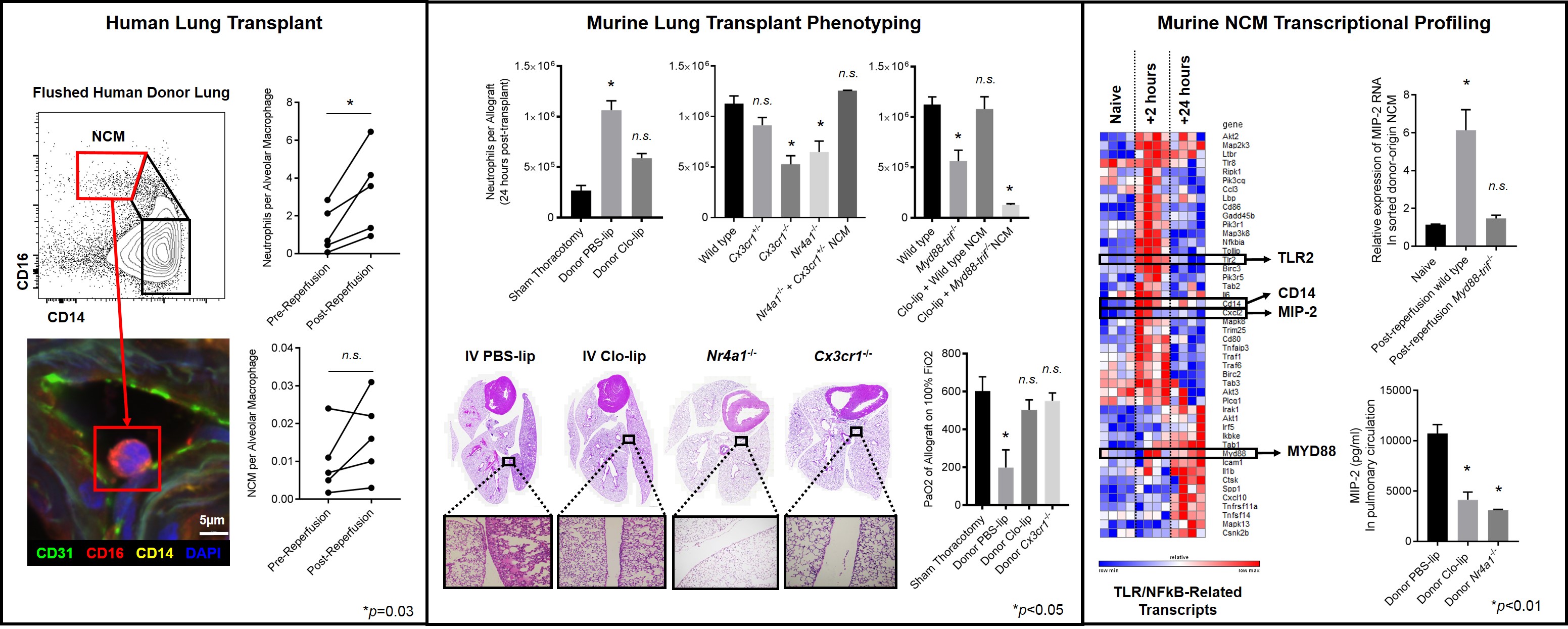Donor-Derived Nonclassical Monocytes Produce MIP-2 to Recruit Recipient Neutrophils and Cause Ischemia Reperfusion Injury After Lung Transplant.
1Northwestern University, Chicago
2Washington University, St Louis
Meeting: 2017 American Transplant Congress
Abstract number: 548
Keywords: Inflammation, Lung transplantation, Mononuclear leukocytes
Session Information
Session Name: Concurrent Session: Pathways in Ischemia Reperfusion
Session Type: Concurrent Session
Date: Tuesday, May 2, 2017
Session Time: 4:30pm-6:00pm
 Presentation Time: 5:18pm-5:30pm
Presentation Time: 5:18pm-5:30pm
Location: E351
Purpose: Primary graft dysfunction (PGD), the primary cause of early mortality after lung transplant, is mediated by neutrophils. However, neutrophil depletion may not be clinically viable due to their importance in host defense. We show that nonclassical monocytes (NCM) are retained in donor lungs, recruit recipient neutrophils and their depletion abrogates PGD without affecting pathogen-directed immunity.
Methods: FACS and microscopy were used to characterize lungs. Allogeneic murine single lung transplants were performed. Histology, PaO2, Evans Blue Dye leak, and wet-to-dry ratio were used to assess PGD. RNAseq was used for transcriptional profiling of sorted NCM. RT-qPCR and ELISA were used to quantify MIP-2 mRNA and protein.
Results: In human donor lungs, NCM remained endothelial-bound despite flushing. Persistence of NCM was associated with rapid neutrophil influx after reperfusion. In mice, donor NCM depletion with clodronate liposomes; deletion of NR4A1, an orphan nuclear receptor necessary for NCM formation; or CX3CR1, an NCM surface receptor/adhesion molecule, suppressed neutrophilia and protected against PGD. Myd88-trif-/- allografts that lack Toll-like receptor (TLR) signaling were also protected. Reconstitution of NCM-depleted donor lungs with wild type, but not Myd88-trif-/- NCM, restored neutrophil influx. Post-reperfusion donor NCM upregulated TLR2/CD14-MYD88 pathway genes and MIP-2, a key neutrophil chemoattractant. MIP-2 was increased in allograft circulation only when functional donor NCM were present and neutralization of MIP-2 abrogated neutrophil influx. Depletion of NCM did not impair the neutrophil response to lipopolysaccharide.
Conclusions: Donor-derived NCM, retained in donor lungs, recruit neutrophils through the production of MIP-2 via a TLR2/CD14-MyD88 pathway. Depletion of donor NCM represents a novel and clinically relevant therapy, as it may abrogate PGD without affecting recipient host defense.
CITATION INFORMATION: Chiu S, Zheng Z, Akbarpour M, Fernandez R, McQuattie-Pimentel A, Reyfman P, Anekalla K, Kreisel D, Perlman H, Budinger G, Misharin A, Bharat A. Donor-Derived Nonclassical Monocytes Produce MIP-2 to Recruit Recipient Neutrophils and Cause Ischemia Reperfusion Injury After Lung Transplant. Am J Transplant. 2017;17 (suppl 3).
To cite this abstract in AMA style:
Chiu S, Zheng Z, Akbarpour M, Fernandez R, McQuattie-Pimentel A, Reyfman P, Anekalla K, Kreisel D, Perlman H, Budinger G, Misharin A, Bharat A. Donor-Derived Nonclassical Monocytes Produce MIP-2 to Recruit Recipient Neutrophils and Cause Ischemia Reperfusion Injury After Lung Transplant. [abstract]. Am J Transplant. 2017; 17 (suppl 3). https://atcmeetingabstracts.com/abstract/donor-derived-nonclassical-monocytes-produce-mip-2-to-recruit-recipient-neutrophils-and-cause-ischemia-reperfusion-injury-after-lung-transplant/. Accessed December 25, 2025.« Back to 2017 American Transplant Congress
